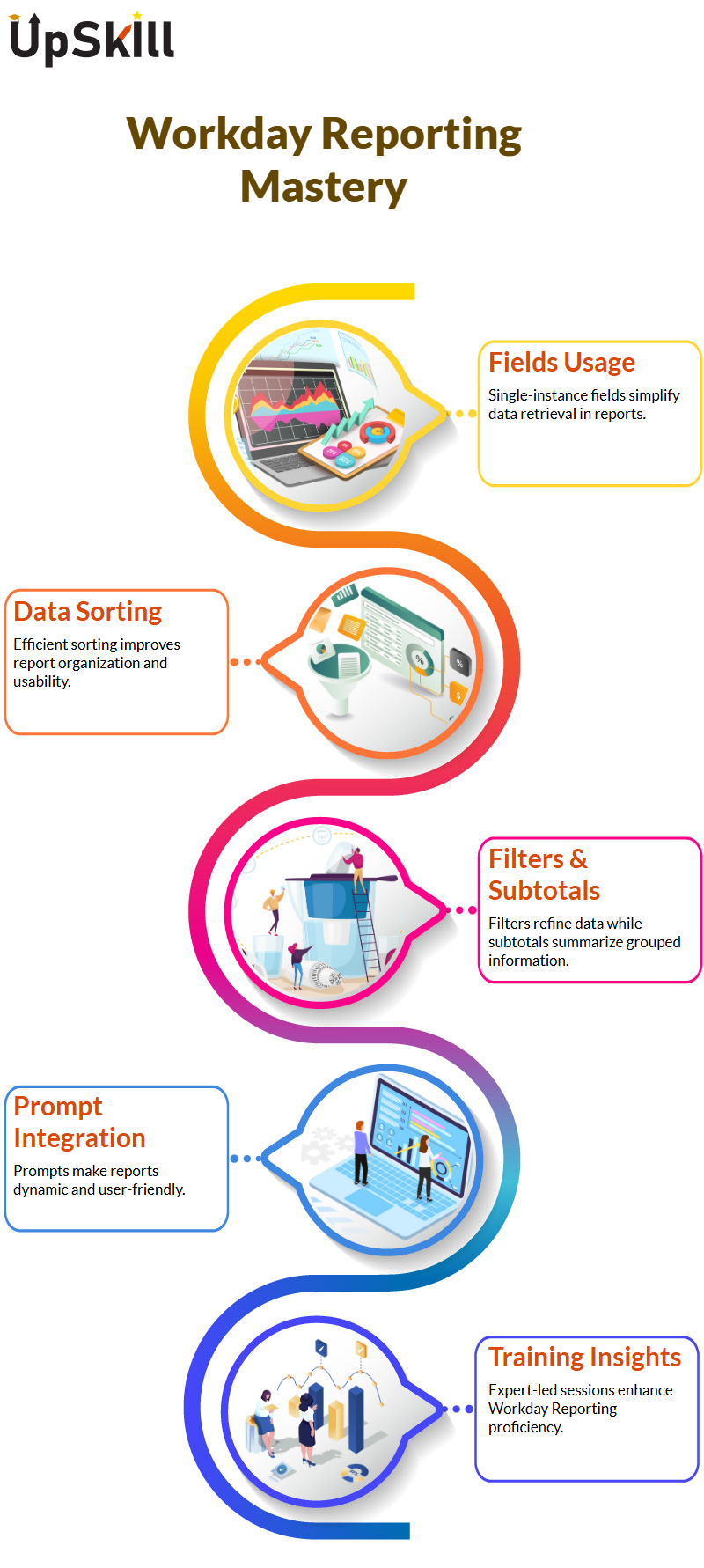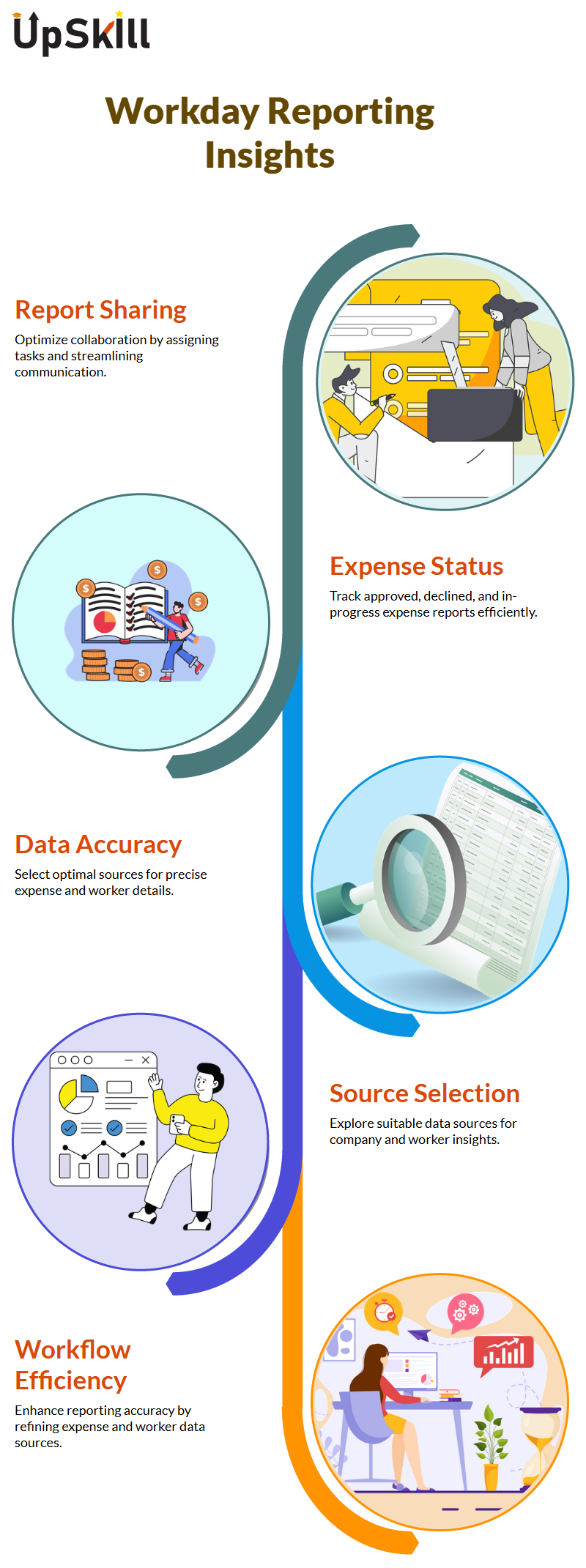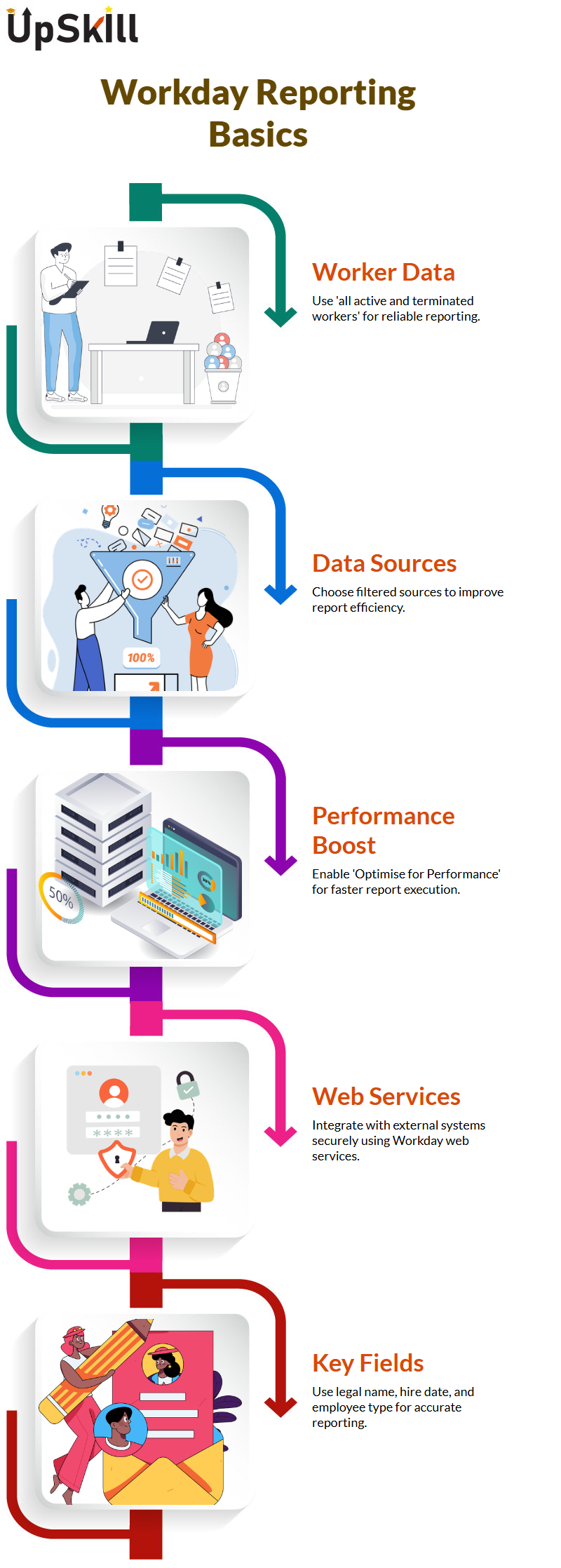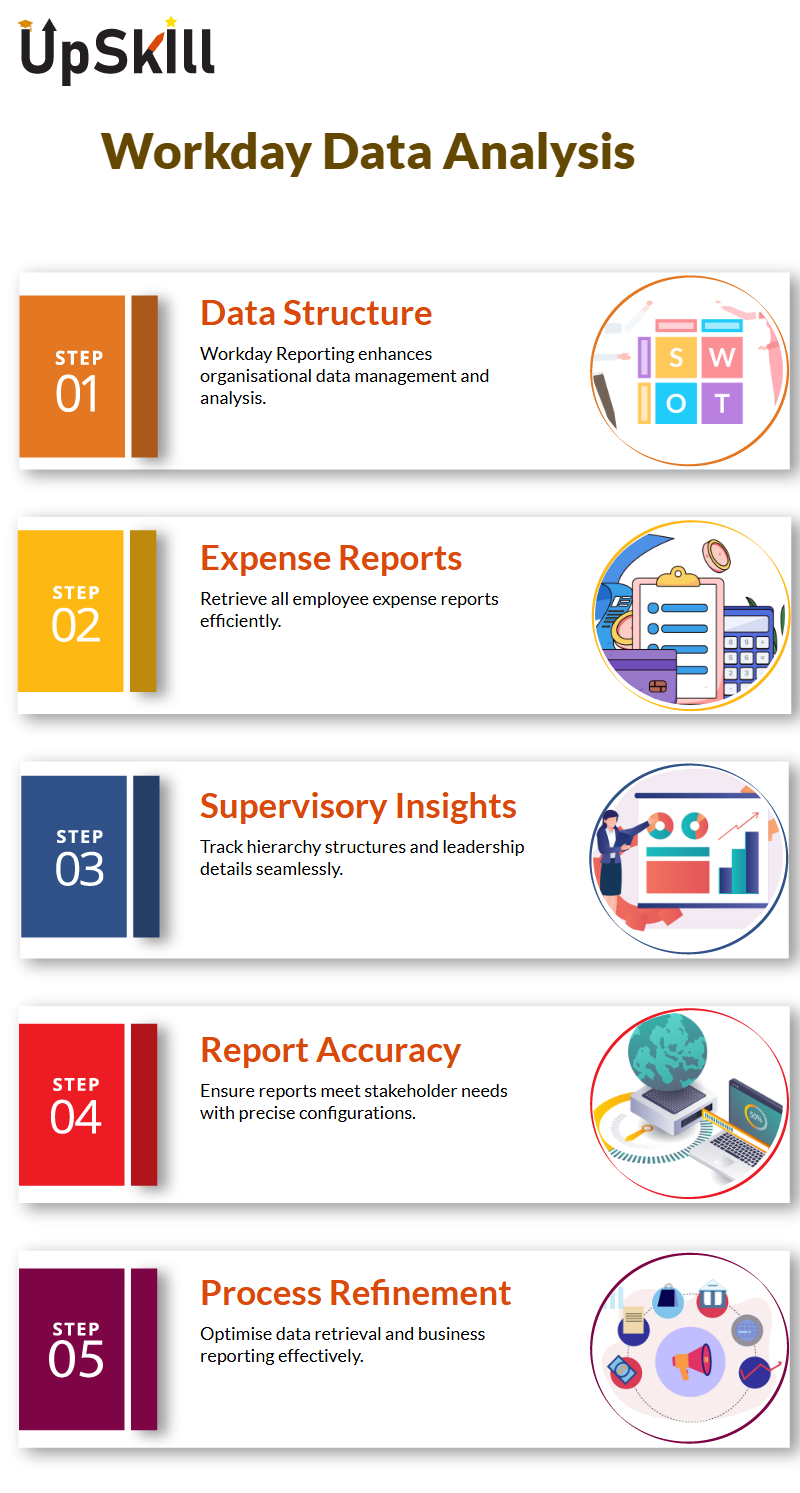Top Workday Training Institutes in Bengaluru near me
Workday Reporting Training in Bengaluru
Today, we will cover all the fundamentals of Workday Reporting Training in Bengaluru and teach you how to build advanced reports from scratch.
Let’s begin by covering the essentials selecting an effective data source is crucial to obtaining the results you require.
Next, we will explore building columns which display exactly the data that meets our specifications.
At Workday Reporting Services, including our Workday Reporting training in Bengaluru, we will also assist in setting fields from primary business objects and related objects, ensuring your Workday Reporting structure remains robust and well-defined.
Mastering Fields and Instances with Workday Reporting
Fields play a crucial role in Workday Reporting. We will explain single-instance fields and demonstrate their functionality within your reports, providing examples to illustrate how these can simplify data retrieval.
As part of our Workday Reporting training in Bengaluru, sorting is another key aspect of Workday Reporting, and our experts will walk you through various sorting methods and how best to organise data efficiently for reports.
Filters, Subtotals and Prompts using Workday Reporting
Filters and subtotals can transform Workday Reporting by helping you focus on relevant data more easily, while subtotals provide a quick overview of grouped information.
As part of our Workday Reporting training in Bengaluru, we’ll show how seamlessly these features fit within reports.
Prompts make Workday Reporting engaging. Here, we will show you how to incorporate prompts, such as data source prompts, into your reports to make them dynamic and user-friendly.

Sharing and Managing Reports in Workday Reporting
Collaboration within Workday Reporting is vital; therefore, as part of our Workday Reporting training in Bengaluru, we will teach you how to share reports with the appropriate users, assign report tasks effectively, and streamline communication for improved workflow. We promise!
We will also address best practices to make sure the shared reports remain accurate and valuable for everyone involved.
Building a Practical Workday Reporting Example
Let’s create a report to retrieve all expense report statuses for employees, including those marked as ‘approved’, ‘declined’, and ‘in progress’.
Let me show you step by step how to achieve success when creating such a report. Alongside statuses, we will also include information such as employee activity, legal names, hire dates, locations and supervisory organisations.
Additionally, we will focus on expense report details, such as due dates, total amounts, and statuses, to present accurate information while simultaneously converting all currency amounts to US Dollars, ensuring consistency among international data in Workday Reporting.
Once we know our report fields, let’s select an appropriate data source in Workday Reporting. Now that we understand which objects will comprise our report and extract fields from them, these decisions will impact both efficiency and accuracy when creating reports in Workday.
By understanding your company’s requirements and goals for employee and expense reporting details, we’ll assist in selecting an optimal data source to meet them as part of our Workday Reporting training in Bengaluru.
Through Workday Reporting Expense Data Sources for Accuracy
Focused analysis on data sources that could meet reporting needs through Workday Reporting.
At first, the expense items appeared promising; however, it later turned out that this data source only provided individual expense item details and did not cover worker details that I found essential.
Consider ‘Expense Payment,’ which focused specifically on expense payments; unfortunately, it did not meet reporting needs, as goal involved expense reports rather than payments.
Discovering Data Sources in Workday Reporting: After extensive exploration within Workday Reporting and through Workday Reporting training in Bengaluru, identify expense report lines and itemisation as the correct data sources for worker details and expense reports.
At first glance, this application appeared promising because expense reports were the primary view. However, upon closer investigation, you soon discover that it’s designed primarily for company-level reporting, without providing detailed insights into individual workers.
Finally, they identified expense reports for workers as one data source with expense reports as their primary business object, and also providing worker details.
At first, this option seemed promising: a seamless experience without specifying roles such as manager or financial analyst; however, it failed to deliver fully, as it was expected to give a different result.
Exploring Workday Reporting's Worker-Based Data Sources
Search continued, and this time, the focus shifted more closely toward worker data sources that were directly related to expenses as part of this business object.
Want to explore whether using expenses as a source could provide some interesting leads that hadn’t already been considered.
This approach provided me with new methods for gathering data that effectively meet objectives. You will encounter various worker-related data sources, and disregard irrelevant ones, such as absence-related or union membership data, while still meeting all your objectives.
Workday Reporting proved an indispensable resource, enabling me to locate relevant data sources pertinent to workers and expense reports.

Workday Reporting for Active and Terminated Workers
When creating reports to gather details on workers, always use the ‘all active and terminated workers’ data source, as it contains every worker active or terminated within your organisation. This data source can provide reliable results in most scenarios.
When creating reports about contingent workers, such as contractors, using the ‘all contingent workers’ data source is ideal since its filters already perform optimally without needing manual adjustments.
Workday Reporting becomes much simpler once you understand the data sources that contribute to it. Utilising filtered sources allows reports to run more quickly and efficiently, while manual filters slow down this process.
The preferred data source for current and past employees, excluding future hires, is “all active and terminated workers”. For future hires, opt for “all workers’ instead.
Workday Reporting enables me to track who will join after effective date. For current needs, use “all active and terminated workers”, as this suits purposes perfectly.
Selecting an Appropriate Data Source in Workday Reporting: Finding a suitable data source in Workday Reporting is of utmost importance when creating reports excluding contingent workers; for these types of reports, the ‘all active employees’ is generally safest.
However, if your report also requires contingent workers, consider using “all active and terminated workers”.
Report execution can become faster with these tools, saving both time and resources during the report generation process.
In Workday Reporting, selecting an index data source may be preferable if your report relies on high-performing datasets; otherwise, a standard source will suffice.
Working efficiently and accurately requires selecting an ideal source. With Workday Reporting, this selection is crucial to ensure the efficiency and accuracy of reports generated using Workday Reporting.
Optimising Performance through Workday Reporting
Workday Reporting prioritises performance optimisation, especially when using index data sources such as SQLite.
Enabling the “Optimise for Performance” checkbox will significantly enhance the responsiveness of reports created using these sources.
As part of the Workday Reporting training in Bengaluru, Workday Reporting offers flexibility by enabling access to standard data sources, thereby providing users with more insight into their reports and those based on their specific data structures.
You may want to switch this off depending on the insights required from them. Generally, however, Workday Reporting allows access only, when necessary, based on the insights needed from it.
Workday Reporting and Web Services
With its web service functionality, Workday Reporting enables seamless integration with external systems, ensuring secure data exchange with third-party applications and facilitating the sharing of applications and systems with external parties.
Workday Reporting’s web services in Workday Reporting Training in Bengaluru enabler feature can be helpful when working with integration teams that use XML-based data transfers; however, you do not require web services activation for reporting purposes. In such instances, proceed without activating these Workday Reporting features.
Workday Reporting's Worker Fields
We utilise Workday Reporting to gather worker details. Starting with their legal name, hire date, location, and cost centre details, we proceed from there.
These are currently the areas we are focused on; expense coding-related details are not included in today’s agenda.
Initially, our focus will be on straightforward delivery fields without calculated fields for now. Once we master them, they may become part of future demos.
Starting with their legal name is key in narrowing down our search. Imagine searching through numerous options such as “Name Changed, Short Display Format or No First Letter.”
Only then would we realise they weren’t quite appropriate – what we need here is their complete and simple legal name.
Always double check a field’s description to ensure it aligns with our purpose, which is crucial when using Workday Reporting.
Next is hiring date finding this field on Workday Reporting shouldn’t be hard, as it’s part of its delivery field list.
Notably, Hire Date gives only the employee’s most recently hired date; in cases where an individual is rehired after previously leaving an organisation, they are hired back again after previously departing, only their most recently hired date will appear here, being mindful of these nuances will allow us to gather accurate data sets.
A key consideration in Workday Reporting is the employee type. This field depends on each worker’s primary position.
Employees holding multiple jobs need only submit one field; additional positions require calculated fields.
As an initial step, use only the Employee Type field provided to keep things straightforward. These essential fields form the backbone of effective Workday Reporting.

Investigating Workday Reporting Employee Types
Workday Reporting Workday Reporting Training in Bengaluru allows you to explore employee data in greater detail. One worker might belong to multiple employee types it’s fascinating!!!
They could include full-time, part-time, interns, contractors, and many more classifications.
Workday Reporting provides unparalleled flexibility to capture a worker’s status across various categories accurately.
Utilising Workday Reporting’s Locate Employees by Country feature, you can retrieve location details about an employee, such as their country of origin.
Focusing solely on an employee’s country of residence allows you to easily pinpoint any additional location data, such as region or city information, unless required.
This makes it simple by allowing you to select an appropriate field. Likewise, Workday Reporting supports Supervisory Organisations, which makes tracking employee performance effortless and straightforward.
Supervisory organisations are one of the cornerstones of Workday Reporting. These groups comprise clusters of team members who report directly to a single manager.
Workday Reporting’s ability to map these hierarchies offers incredible insight into team structures and leadership positions.
Cost Centres and Financial Insights in Workday Reporting:
Workday Reporting’s Training in Bengaluru cost centres that primarily serve financial analysis. They help manage payroll, compensation plans and expense reports as well as identify areas for improvement or revenue generation.
Human Resources typically manages cost centres as part of financial administration; Workday Reporting offers powerful tools that allow HR personnel to analyse and utilise cost centre information effectively.
Delineating Location Hierarchies in Workday Reporting
One powerful feature of Workday Reporting is its ability to create location hierarchies. Starting at broad regions, such as North America or Asia, and branching down further through countries, states, cities, or specific localities, Workday Reporting can enable you to track employee locations with incredible detail.

Workday Reporting to Analyse Data Effectively
Workday Reporting has transformed how organisation’s structure and analyse their data. With its flexible features, including location-based insights, supervisor details, and company hierarchy structures, Workday Reporting provides practical data analysis at scale.
These features ensure stakeholders receive exactly the information they require when making critical decisions.
Since some fields, such as viewing date, weren’t readily accessible, we had to examine related business objects to capture all required data within a single report.
Workday Reporting Training in Bengaluru enables the retrieval of every expense report submitted for an employee, regardless of status, quickly and effortlessly.
By linking primary and related business objects using appropriate fields, all expense reports were seamlessly integrated into our reports without missing any crucial details.
Navigating Workday Reporting requires patience and an open eye. From collecting details about workers or supervisors to building reports that meet optimal usability needs, Workday reporting must always be approached carefully to avoid miscalculation or errors in the retrieval of details.
Workday Reporting Training in Bengaluru offers multiple fields related to expense reports, catering to various needs. If a stakeholder wants to see all expense reports an employee has submitted since joining, filtering on status fields becomes essential.
Workday Reporting has simplified data management, streamlining how data is pulled and structured for analysis and presentation.
Not only is information captured about supervisory organisation details, but also expense reports, cost centres and other essential business aspects that I require for business success.
As part of Workday Reporting queries, consistently identify which related business objects can be incorporated into the report to create comprehensive reports that efficiently meet business needs.
By understanding these relationships, I’m better able to craft reports that effectively meet business requirements.
Workday Reporting features several fields that outline an employee’s organisational structure. To ensure an insightful final report, identifying the appropriate field according to stakeholder needs can be challenging but essential in providing accurate reports.
Workday Reporting makes it simple and accessible to investigate relationships between worker data and expense reports, such as expense claims or expense analysis reports. With fields like supervisor organisation or hierarchical structure analysis available within Workday Reporting, exploring these relationships is made simpler than ever.
Workday Reporting requires scrutiny for optimal setup. Before including business objects in reports, check that their configuration meets requirements first.
Workday Reporting’s versatility in Bengaluru makes it the perfect solution to meet the reporting needs of stakeholders at every organisation, whether for financial reporting or organisational structuring, making the configuration of reports exactly as required an invaluable advantage.
Manually explore Workday Reporting fields to identify those most pertinent to me. A search for supervisor organisation provided essential details, enabling me to select appropriate fields for reports.
Technology has completely revolutionised how companies access worker data. Ensuring stakeholder requirements are fulfilled when managing expense reports is an essential aspect of an effective system.
Prioritising accuracy when editing reports in Workday Reporting should always be the top priority, as accurate fields provide crucial insights into employee data, supervisor hierarchies, and financial tracking.
Supervisory details are an integral component of Workday Reporting. By selecting appropriate fields, you can help create reports that efficiently serve stakeholders.
Workday Reporting’s expense reports are among the most frequently used features, so understanding their relationship to worker views helps organisations maintain accurate financial records.
Workday Reporting extends beyond simply gathering data; it also involves structuring it in a manner that aligns with business processes.
Every time you use Workday Reporting, consider refining your approach to capture all relevant data efficiently in reports.
With Workday Reporting Training in Bengaluru, the Wise Reports feature of Workday Reporting can help you gain valuable insights that make reports even smarter.


